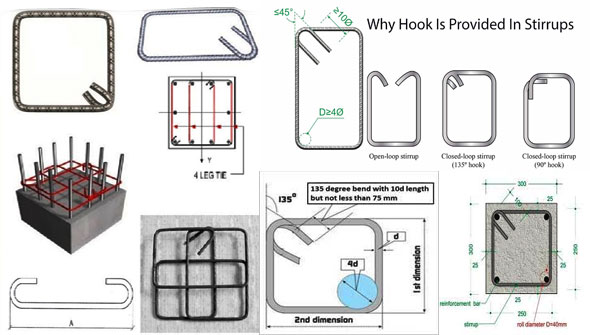Types of Stirrups in Reinforcement
- Concrete Cost Estimator
- Concrete Continuous Footing
- Landscape Bidding and Estimating
- Construction Cost Estimating
- Concrete and steel cost estimation
- Construction Cost Estimate Breakdown
- Construction Estimating Worksheet
- Home Construction Cost Estimate
- Estimate Pricing Sheet
- Sheet for General Contractor
- Construction Cost Estimate
- Labor Materials Cost Estimator
- Masonry Estimating Sheet
- Sheet for Building Contractor
- Construction Schedule Bar chart
- General Cost Estimator Sheet
- General Construction Estimate
- Building and Road Estimating Sheet
- Detailed expense estimates
- Door and Window Takeoff Sheet
- General Construction Cost Estimating Sheet

The purpose of stirrups is to withstand the later shear stress and diagonal tension stress in RCC structure. Therefore, the stirrups allow to resist the buckling failure in columns.
Benefits of the Stirrups in Beam and Column reinforcement:
1. The stirrups are arranged in beam and column to retain the concrete and the main rods jointly.
2. It sets the rods in the similar alignment.
3. To keep the beam and column safe from the buckling and shear failure.
4. The stirrups defy the rods under compression or tensile force.
The spacing of stirrups vary depending on the design for both column and beam. The least spacing should be 100mm and the maximum is 250mm, according to the diameter and number of the rod.
Based on the nature of construction, the following types of stirrups are mainly utilized in beam and columns :-
Single Legged Stirrup, Two-legged or Double Legged Stirrups, Four-legged Stirrups, Six-legged Stirrups.
Occasionally, three-legged stirrups are also found in construction.
Single Leg Stirrups: The single leg stirrups are used seldom since it is useful while binding only two rods.
Also Read: How to organize stirrups in column efficiently based on the structural drawings
Two-Legged Stirrups: These types of stirrups are usually and frequently used. To set up this stirrups, minimum 4 number of the rod is necessary.
Four-Legged or Multi-Legged Stirrups: These types of stirrups will be necessary for beams containing longer web widths. It is recommended to apply multiple-legged stirrup in allowed situations since they accelerate control of shear cracking, better control longitudinal splitting cracks and facilitate maintain the transmission of shear through aggregate interlock.
For more detail information, go through the following video tutorial.
Video Source: L & T - Learning Technology

- Application of concrete calculator
- Roofing Calculator can streamline the roof estimating process
- House construction cost calculator
- Engineering column design excel spreadsheet
- Material Estimating Sheet with Excel
- Materials List and Cost Estimate Worksheet
- Concrete Slab Estimating Calculator Sheet
- Common types of foundations for buildings
- Online calculation of construction materials
- Estimating with Excel for the Small Contractor
- Concrete Beam Design Spreadsheet
- Virtual Construction Management app for construction
- Autodesk’s Project Skyscraper
- Reed Construction’s Reed Insight
- Manage your construction project documentation
- Costimator, the popular cost estimating software
- On Center Software for construction professionals
- Free Construction Estimating Software
- Plumbing Calc Pro
- Cost Estimate Worksheet
- HVAC Piping Quantity Takeoff Worksheet
- Construction Estimating Software Sheet
- Estimate Cost Templates
- Construction Punch List
- Construction cost estimating template consisting estimating basic
- Gantt Chart Template for Excel
- Download Civil Engineering Spreadsheets with Verification
- The Building Advisor Estimating and Budgeting Worksheet
- Spreadsheet for design of concrete bridge
- Construction Estimating Software Free








